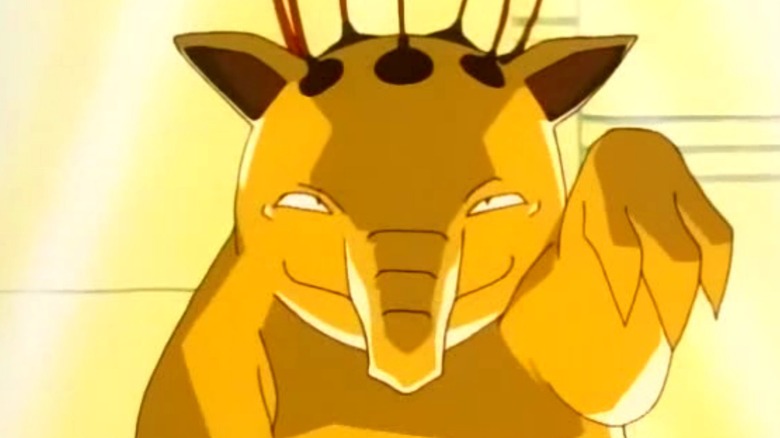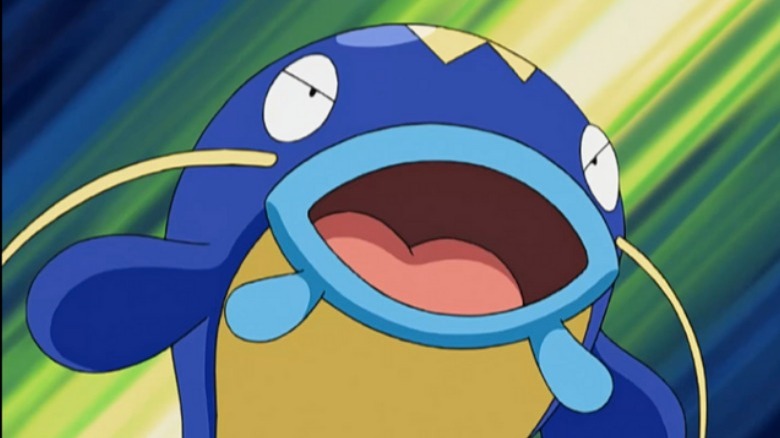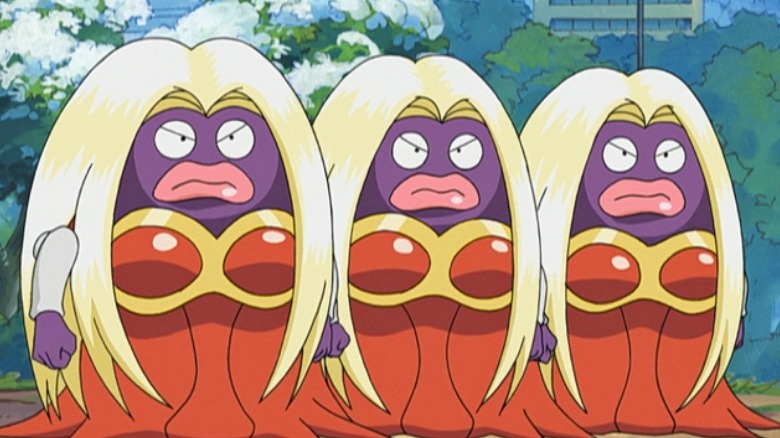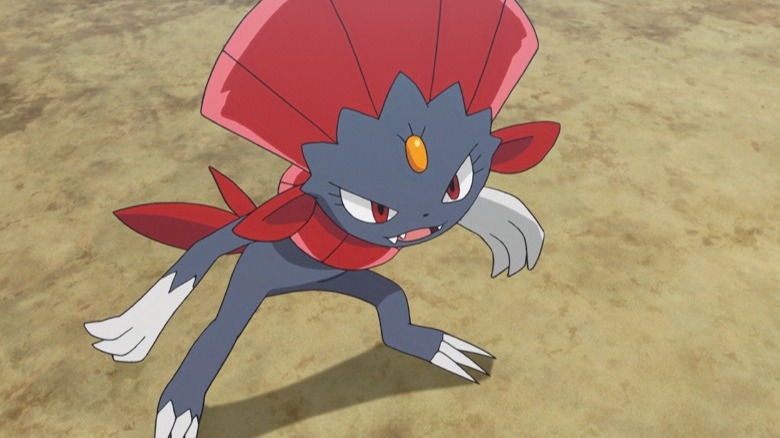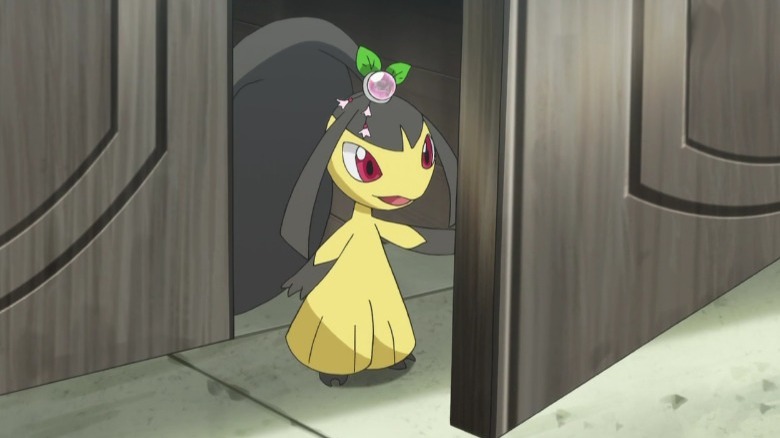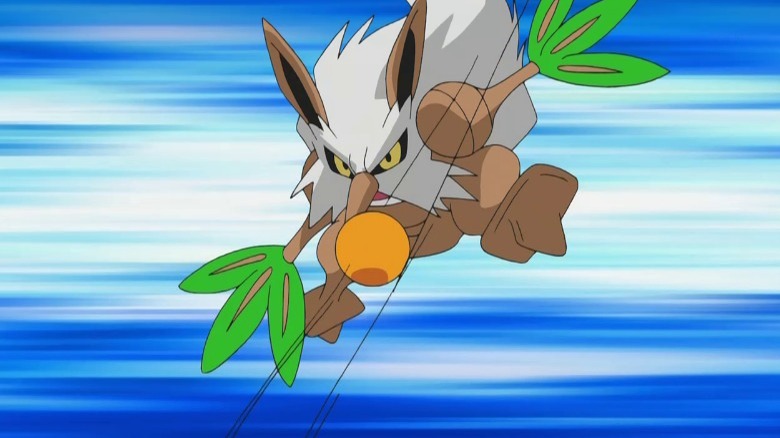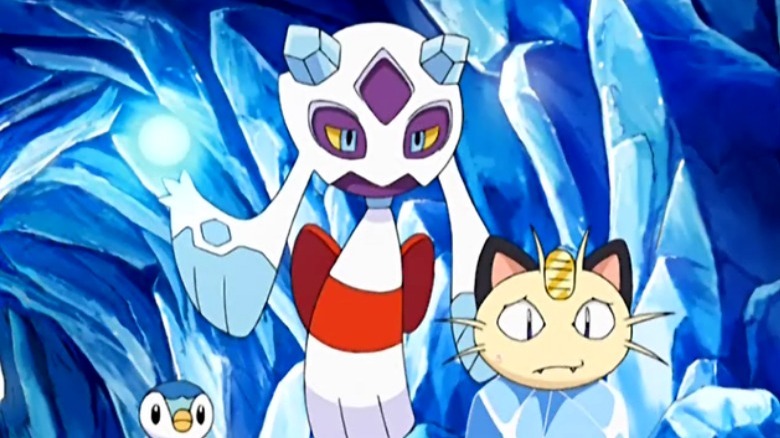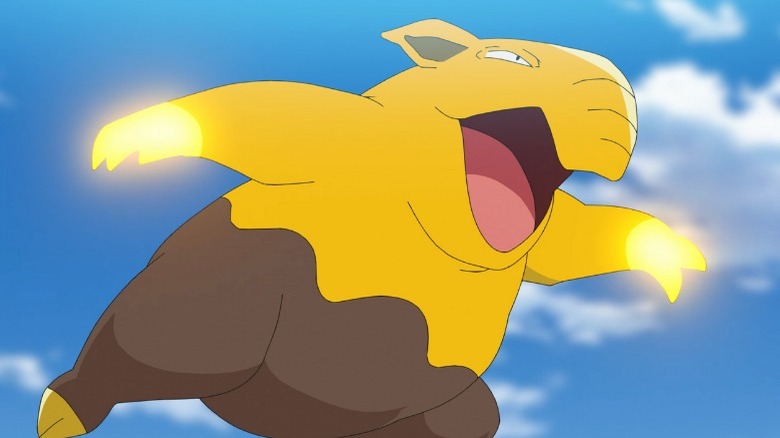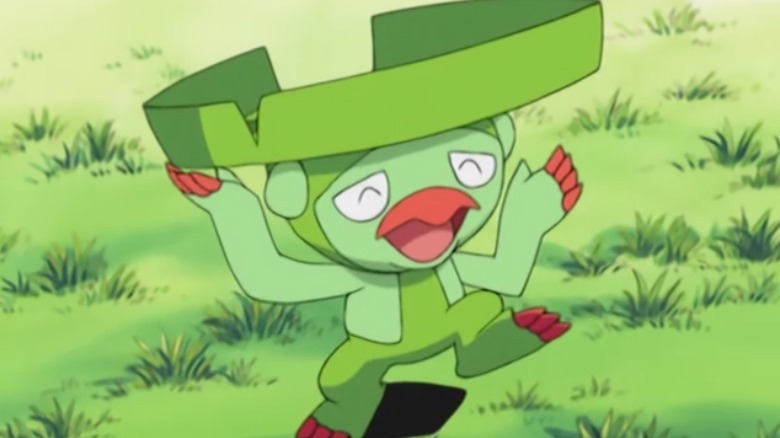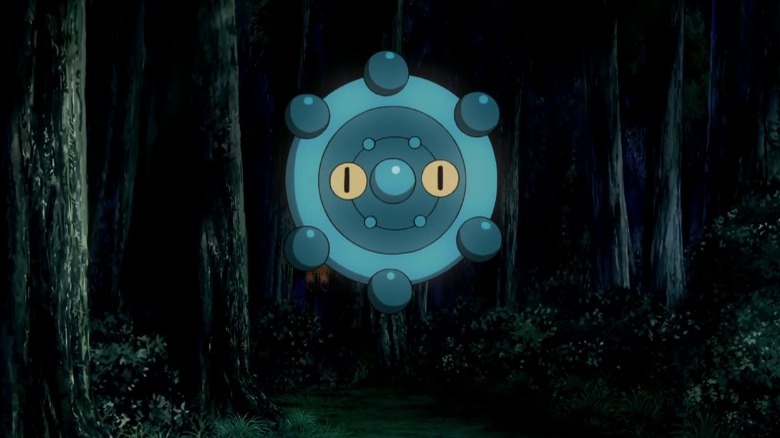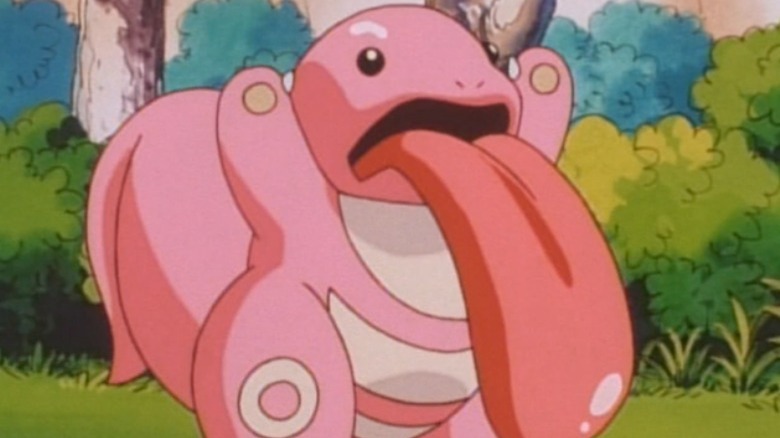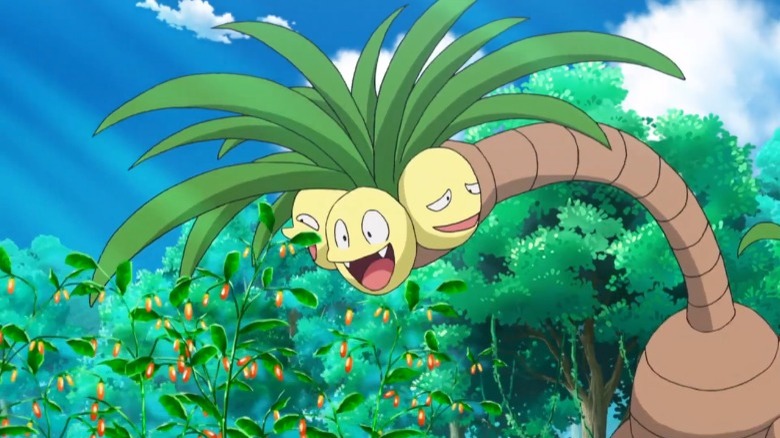Pokemon That Are Based On Disturbing Myths
Pokemon come in a grab bag of shapes, many of which are based on real creatures or objects. Some of these inspirations are occasionally recycled, but that sort of comes with the territory; there are more dog breeds in the real world than there are Pokemon species in Unova, so of course a Safari Zone's worth of catchable creatures would be based on man's best friend. However, since Pokemon are fantastical creatures that can do everything from change the weather to create black holes, many of their inspirations live within the realm of fantasy.
Plenty of Pokemon have ties to mythological creatures and stories, and we're not just talking about dragons, fairies, and ghosts. Moreover, some of these real-world myths are downright disturbing. You might assume that since the "Pokemon" series is rated E for everyone, developers would pick the most kid-friendly ghost stories, but as anyone who has read the Pokedex will tell you, the world of "Pokemon" is anything but friendly. Roserade lures in prey with its sweet-smelling hands, and Gengar's gigantimaxed mouth is rumored to be a literal portal to hell — why should the influences of different Pokemon be any more sanitized?
Since the true inspirations developers drew from are usually kept under lock and key (with the exception of Pikachu's squirrel origins and the kaiju-themed inceptions of Rhydon and Nidoking), it's up in the air whether Pokemon we think were inspired by disturbing myths actually were. However, thanks to numerous context clues, we can say with significant certainty that the Pokemon included in this list probably started life as creepy stories.
Whiscash
Many Pokemon inspirations are only skin deep. For instance, Lanturn, a blue and yellow angler fish-like Pokemon, is clearly based on an angler fish, electric powers notwithstanding. Surely that must mean Whiscash, a blue and yellow catfish-like Pokemon, is likewise based on a catfish. Well, yes, but not the kind of catfish you're thinking of. Its inspirations are a little more surprising.
While many cultures around the world have invented novel mythological creatures, sometimes creativity only goes as far as "it looks like a normal creature but way bigger." One such animal is the Onamazu — or Namazu, depending on the translation — which is a catfish of titanic proportions. According to Japanese legend, this gigantic bewhiskered menace can cause earthquakes just by shifting its mass. The Onamazu is said to be guarded by a member of the Shinto pantheon, but whenever the god slacks off, the perilous piscine starts to roll about, and all of Japan pays the price.
If this connection between earthquakes and catfish sounds familiar, you probably have read Whiscash's Pokedex entries. When the Pokedex isn't talking about the creature's eating habits, it mentions Whiscash's ability to both detect and cause earthquakes. And, Whiscash is one of a handful of Pokemon that can learn the move Earthquake naturally (at level 40).
Given these similarities, it's fairly obvious that Whiscash is based on one of Japan's most unintentionally destructive mythological creatures. Either that or the Pokemon references a real-life study that demonstrated catfish can predict earthquakes with semi-reasonable accuracy.
Jynx
Jynx is one of the most controversial Pokemon in existence. The creature has prominent (and human-like) features, and it originally sported coal-black skin that elicited accusations of blackface. Even worse, the Pokemon's first anime appearance was the episode "Holiday Hi-Jynx," where Jynx helped Santa Claus — some viewers took this as an allusion to Zwarte Piet, Santa's offensively blackfaced helper from Dutch legends. While Jynx's true origins are shrouded in mystery, its most likely inspiration might acquit the Pokemon. Mostly.
While some gamers believe Jynx is tied to the ganguro fashion trend of blonde hair and fake tans, the more likely explanation is that Jynx is an extremely sanitized Yama-Uba. Unlike most monsters of Japanese myth (known as yokai), Yama-Uba are almost completely human. They have prominent mouths, golden white hair, and red dresses (kimonos) — just like Jynx. Yama-Uba also have a taste for human flesh, which is the result of karmic irony. According to legend, poor families had to abandon elderly grandmothers on mountains to survive times of extreme famine, and the marooned grannies became Yama-Uba out of spite and hunger.
Yama-Uba explain virtually everything about Jynx. The yokai tend to live on cold mountains, and Jynx are Ice-types that make mountains their homes. Yama-Uba have sorcerous powers, which is likely why Jynx are also part Psychic-type. What about Jynx's original black skin? That can be explained by Japanese Noh theater. Actors who play the role of Yama-Uba tend to don dark masks, and they close out the productions with a long dance, which might explain why many Pokedex entries say Jynx love to dance.
While accusations of blackface pointed at Jynx have died down ever since the Pokemon was recolored purple, it's probable the creature's original developers simply didn't understand the offensive context of blackface.
Sneasel and Weavile
Look at a myth, any myth, and you will probably see a story invented to explain something early cultures couldn't comprehend. For instance, the legend of the Cyclops was likely penned because Greek explorers couldn't wrap their heads around elephant skulls, while early Welsh people believed corgis were created by fairies as battle mounts (no seriously). A similar scientifically explainable myth might have inspired two Pokemon.
At first glance, Sneasel and Weavile are based on real-world weasels. After all, when you chop their names in half and combine the pieces, that's the word you get (that and "sneavile"). But if the Pokemon were based on weasels, why are they part Ice-type, and why do Weavile hunt in packs? Weasels are supposed to be solitary hunters. That's because Sneasel and Weavile are based on a different kind of weasel, the Kamaitachi.
According to Japanese legend, Kamaitachi are whirlwind-fast weasels with steel claws that leave bloodless scars. Although, myths vary from region to region. In some areas, Kamaitachi hunt in groups of three — One trips its prey, one slices them up, and one applies a healing salve. In others, though, the Kamaitachi just stop at step two and let their victims bleed. These myths mirror Sneasel and Weavile's high speed stat, emphasis on claw attacks, and pack mentality. Their Ice-typing, however, is more based on the real-world explanation for Kamaitachi. In 1911, a medical journal published an article on "spontaneous wounds." Dubbed "Kamaitachi disease," these bloodless scars were reportedly the result of vacuums caused by stray air currents on mountains during thunderstorms.
Usually, Pokemon based on myths just draw from the fiction, but the people behind Sneasel and Weavile also decided to take cues from old scientific beliefs, just to spice things up.
Mawile
Most Pokemon that borrow from mythology take cues from Japanese stories and yokai — the developers are Japanese, after all. Many yokai are born out of punishment and exist only to suffer, while others met out punishments to teach people a lesson. One Pokemon was based on the latter kind of yokai.
When the "Pokemon" series introduced Fairy-types, many creatures adopted the element, one of which was Mawile. The Pokemon suddenly found itself in the same family as cute creatures such as Marill and Togepi, despite using a modus operandi more becoming of a Dark or Ghost-type. According to Pokedex entries, Mawile lulls victims with its cute face, then clamps down on them with the giant, hair-like maw in the back of its head. It's a figurative and literal heel turn. Given these features, Mawile is clearly based on the Futakuchi-Onna, a human-like yokai whose only unusual features are a mouth in the back of her head and the prehensile hair that shovels food into it.
Futakuchi-Onna differ from story to story. Some legends tell of a miserly man who marries a woman only because she works hard and never eats a bite in return. However, his food stores steadily decrease because his wife is a secret Futakuchi-Onna. Other stories tell of a horrible stepmother who starves her stepdaughter to death and is transformed into Futakuchi-Onna as divine punishment, forced to feel the hunger pangs of her deceased stepchild if she doesn't feed her second mouth.
Despite the variety of stories, Futakuchi-Onna generally only ate away at the food stores of the people they punished. If it were a Mawile in these tales, the victims wouldn't be so lucky.
Shiftry
Some Pokemon inspirations are as plain as the nose on their face. This is doubly so when the nose is a foot long.
A cursory glance at Shiftry is more than enough to reveal its influences. The Pokemon is, quite obviously, based on the Tengu of Japanese myth, specifically the Daitengu. These are the head honchos of Tengu society, and scores of lesser Tengu serve under them. Almost every element of Shiftry is taken from the Daitengu, including its mane of white hair and Pinocchio-like nose. Even the Shiftry's feet are shaped like the Daitengu's signature sandals, and instead of holding fans like a Daitengu, Shiftry's hands are fans.
Despite the popularity of Daitengu, as well as Tengu in general, the entire flock of yokai are some of the most polarizing creatures in Japanese myth. For every story you hear of a noble Tengu passing along their preternatural sword techniques to a worthy samurai (or killing an unworthy one), there are at least three tales of malicious Tengu heralding war and disease, as well as kicking up winds that can demolish buildings — Shiftry take after the latter if their Pokedex entries and movepool are any indication. And if that wasn't enough, Tengu were also often blamed for spiriting away children. Thankfully, Shiftry tend to live in isolated forests and let Drifloon and Drifblim do all the kidnapping.
Unlike other Pokemon that draw from mythology, the developers seemingly didn't look past their noses to create Shiftry's look and lore.
Froslass
Since "Pokemon" has used the Ghost-type element since Gen 1, it only makes sense to base some catchable creatures, such as Froslass, on phantasmal myths. While Froslass is inspired by a popular Japanese ghost tale, you might be surprised to hear it isn't the first time the myth made it overseas.
Since Froslass is an Ice/Ghost-type, its inspiration is pretty obvious: Japan's resident ice ghost, the Yuki-Onna. Many Pokedex entries cite rumors that Froslass are the resurrected souls of women who died on snow-tipped mountains, and that they tend to freeze men, drain their souls, and use their lifeless husks as decorations. That's more or less a one-to-one transcription of how Yuki-Onna hunt, but that doesn't mean all Yuki-Onna are ice-cold murderers.
One of the most famous Yuki-Onna stories has the trappings of a universally tragic tale. The story tells of a woodcutter apprentice. One day, a blizzard trapped the apprentice and his master, so they hunkered down for the night. A Yuki-Onna came and froze the woodcutter but spared the apprentice if he promised to tell nobody. He promised, and one year later, he fell in love with a woman, eventually married her, and had children. Eventually, the man told his wife she reminded him of the Yuki-Onna. In predictable irony, the woman turned out to be the very same ghost, and she would have killed him because he broke his promise if not for their children. She did leave him, though.
If that story sounds familiar, you probably have seen "Tales from the Darkside: The Movie." The segment "Lover's Vow" is an almost beat-for-beat westernization of the tale. Hopefully, though, nobody will ever try to marry their Froslass.
Drowzee and Munna
It's a good idea to drill the notion of "too much of a good thing" into young minds as early as possible. But, instead of letting them learn the hard way, tell them a tall tale about a mythological creature that can help them when evoked sparingly — and then tell them several Pokemon were inspired by it. That should get them interested.
The Drowzee and Munna evolution lines are fairly weird. Both Pokemon and their evolutions are Psychic-types; they superficially resemble tapirs, and they eat dreams. One Pokemon line with those features seems novel, but two? It turns out that the company pulled from the same mythical pot of inspiration twice.
Few mythical creatures eat dreams and only one is associated with tapirs: the Baku. Originally a fever dream chimera of a bear, elephant, rhinoceros, tiger, and ox, the creature (or at least its name) has become synonymous with real-life tapirs. Regardless, the mythological Baku is said to safeguard children from evil spirits and bad dreams. In fact, the Baku lives on a healthy diet of nightmares — ironically, bad dreams give Drowzee, Hypno, Munna, and Musharna indigestion. Children were even encouraged to call the Baku's name if they woke up from nightmares, essentially ringing a dinner bell for the creature in the hopes of having good dreams. Although, according to legend, invoking the Baku too often made it greedy, and it would gobble up nightmares along with a child's hopes and desires, dooming them to empty lives.
Not only do Baku and its Poke-clones teach children the "too much of a good thing" lesson, they also hammer in the message that nobody is above corruption, not even guardian angels.
Lombre
Early "Pokemon" games spliced in references to the real world. For instance, Golduck is supposed to resemble the mythical Kappa thanks to its general shape, beak, and webbed hands and feet. M
The entire Lotad line is seen as one big Kappa homage. Every evolutionary form rocks the associated frog/turtle hybrid motif, and their heads are topped with lily pads that resemble the flat, water-holding plate at the crown of a Kappa's skull. But, while Lotad is more lily pad than frog/turtle and Ludicolo is also part dancing papaya, Lombre evokes the most Kappa-like aesthetic. Not entirely, thankfully.
Like Kappa, Lombre are mischievous little miscreants with slimy skin that reeks of fish. Moreover, Kappa are generally short, no bigger than a child, and according to Pokedex entries, Lombre are constantly mistaken for human children. You might think their lily pad heads would be dead giveaways, but the world of "Pokemon" is full of strange, eclectic fashions. Many characters have worn weirder getups than big, flat hats.
Of course, while Lombre embodies the newer, kid-friendly version of the Kappa, early legends were far more R-rated. Many stories tell of Kappa that would drown swimmers and eat them alive, as well as harass women. If a victim was particularly unlucky, a Kappa would reach up their rear end, pluck out their shirikodama — a ball rumored to house the human soul — and pop it in their mouth like a piece of popcorn chicken.
Given how dark some Pokedex entries can go, we kinda lucked out that Lombre are only mischievous pranksters.
Bronzor and Bronzong
Most Pokemon evolutions follow a logical progression. Sure, they don't always make complete sense, but what else can you expect from a world with apple dragons and railgun shrimp? Then there are the evolutions that seemingly defy sanity. For instance, Bronzor is a bronze disc that evolves into Bronzong, a bronze bell. What does one have to do with the other? Did they make more sense in the beta? Nope, they just require a specific cultural context.
Bronzor and Bronzong's origins date back to the Japanese tale "Of a Mirror and a Bell." As the story goes, local monks asked townsfolk to donate their bronze mirrors to create a bronze bell known as a dotaku, but one mirror refused to melt. The woman who donated the mirror regretted her decision because it had been in her family for generations, and the locals believed her perceived selfishness protected the mirror from the flames. The public shame drove the woman to commit suicide. After she died, the mirror finally melted and the bell was forged, but people flocked to shatter it because the woman left a letter stating anyone who broke it by ringing it would be rewarded with riches. Deafened with frustration (and probably tinnitus), the monks rolled the bell into a swamp.
According to Pokedex entries, Bronzor used to have a highly reflective surface, almost like a mirror, while Bronzong are supposed to bring bountiful harvests, just like a dotaku. But if that isn't enough, the signature ability of both Pokemon (prior to Gen 8) is Heatproof, which parallels the story's mirror's imperviousness to heat.
Most Pokemon take cues from creatures, but Bronzor and Bronzong are some of the only Pokemon inspired by objects from a story.
Lickitung and Lickilicky
If you ever played a "Pokemon" game, odds are you wondered at least once just what the heck Lickitung and Lickilicky are supposed to be. They might look like pink, bipedal salamanders, but they sport tongues that shoot up to 86 feet (that's longer than Eternatus, the biggest Pokemon currently on record) and are prehensile enough to punch and entangle opponents. The answer to this mystery lies in the Pokedex and one disturbing myth.
You don't have to be psychic (or use Psychic-type Pokemon) to guess that most Lickitung and Lickilicky Pokedex entries revolve around their prodigious tongues. Several descriptions note that the Pokemon like to "clean" surfaces with their tongues, but these objects aren't as clean as you think. Plus, anyone unlucky enough to get licked by a Lickitung or Lickilicky will break out in an itchy rash if they don't wash the area immediately. Not surprising given the Pokemon's paralytic saliva ... or inspiration.
Given the Lickitung line's dextrous tongue, affinity for licking things "clean," and harmful saliva, these context clues point in the direction of the Akaname, a filthy yokai that thrives in even filthier bathrooms. The creature is immediately identifiable by its most prominent feature, its serpentine tongue that it uses to "clean" filthy surfaces. But, Akaname are anything but helpful and are believed to spread disease. In other words, any surface that looks like it was cleaned by an Akaname is just as filthy and harmful to the touch as items licked by a Lickitung and Lickilicky.
You normally wash yourself off after being licked by creatures with normal tongues, such as dogs, so why wouldn't anyone clean themselves after being licked by creatures that are 115% tongue like the Akaname or Lickitung?
Exeggutor
When "Pokemon" started, the developers only had a few hundred kilobytes to work with. To save space, many cries were shared between Pokemon, and creature designs had to make do with sparse detail. Several Gen 1 Pokemon fall into the trope of "x with a face on it." For instance, Exeggutor is a palm tree with a face on each of its coconuts. Or is it?
For some reason, many cultures have an odd fascination with trees that bear human heads as fruit. There's the Waqwaq tree, the Ginseng tree, and the extinct Jinmenju. Exeggutor is surprisingly one-to-one with the Jinmenju, feet and psychic (or dragon) powers notwithstanding.
According to stories, Jinmenju fruit didn't just look like human heads, they were also sentient. In fact, anyone who went looking for a Jinmenju probably heard them before seeing them because their fruit laughed constantly. And, if you listen closely to an Exeggutor's cry, it sounds a lot like laughing, doesn't it? One of the easiest ways to collect Jinmenju fruit was to make them laugh so hard they fell out of their trees, at which point they could either be consumed or planted to grow a new orchard of Jinmenju. Likewise, if an Exeggutor head falls off the main body, it rolls away to create a new Exeggcute cluster that can evolve into yet another Exeggutor. Coincidence? Possibly not.
Given the similarities between Exeggutor and the Jinmenju, it's difficult to believe one didn't inspire the other, but if you're not convinced, look at a picture of a Jinmenju drawn by "GeGeGe no Kitaro" creator Shigeru Mizuki. He pictured its human-like heads as distinctly coconut-shaped, just like an Exeggutor. Either Mizuki and Exeggutor's creator were on the same page, or one inspired the other.

